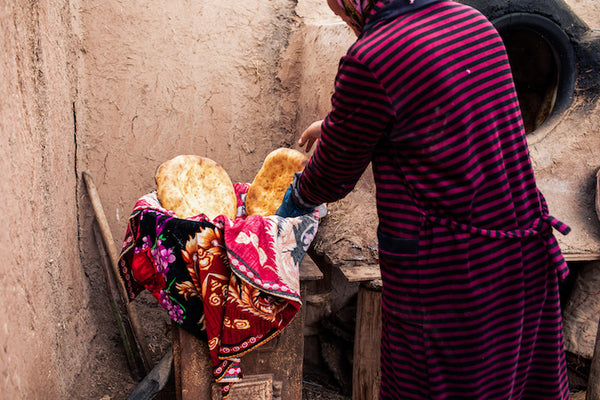Origin of bread

Credit for all photos: Erica Manning
Bread has been around for at least 11,000 years according to the discovery of charred flatbread crumbs found in excavations in Jordan, Western Asia.¹ Leavened bread is thought to originate from Sumer culture (modern Iraq region), a process later refined by the Egyptians.² Flat bread - the topic of this post - is often known to Westerners as Naan or Tandoor Naan and is most commonly associated with our experiences eating Indian cuisine.
Tandyr Nan is, however, known to all of Central Asia as a round, leavened flat bread baked in a clay (tandoor or tandyr) oven. The oven itself is believed to come out of the Indus region (modern Pakistan) over 5000 years ago. ³•⁴
Tandyr Nan in Kyrgyzstan
In other words, bread is ancient and has its roots in Central Asia. It's no wonder, then, that bread is a significant part of Kyrgyzstan's culture. In fact, the Kyrgyz have a saying, "We eat bread with bread!" Bread is a part of every meal and an important offering to guests, often served with tea.

The Kyrgyz shepherd women follow traditional methods in baking their daily bread. At its most basic, flour, water and yeast are mixed together and allowed to rise. Historically, a bit of dough was saved for its fermented yeast to add to the next batch of bread, something we in the West would call sourdough.

Whether it's fresh brewer's yeast or 'sourdough' that's added, the dough is kneaded, formed into circular shapes, and given a flattened center.

The flattened centers are then pricked with a tool called a chekkich and possibly stamped with decorative patterns. The pressing and pricking are done to prevent excessive expansion in the oven.⁴•⁵

The Tandyr

Now it's time for the oven. The tandyr is a vertical clay oven of a cylindrical-type shape. When used vertically, the tandyr is small and essential for nomadic life as it is easily transportable. The tandyr can be more permanently installed, as is the case in these photos, in which case the oven is positioned horizontally. Whichever way the tandyr is oriented, the bread is placed on the oven wall and baked for 6-7 minutes.

Bread. . . and wool?

I entitled this blog, "Bread. . . and wool?" What on earth does bread baking have to do with animal fiber? It turns out that to make the tandyr, a task historically engaged by women, clay is kneaded with goat's hair! or sheep's wool!, salt, and straw using a spiral technique. Oh the goat. Did you know that our founder, Sy Belohlavek, named our company June Cashmere because the English word 'June' sounds like the Kyrgyz word for animal fiber? Sy talks about how animal fiber and textiles literally form the walls above and floor beneath the nomadic shepherd's yurt dwelling, highlighting the fact that animal fiber and textiles have been integral to the Kyrgyz way of life for centuries. Now to understand that animal fiber even has a role in baking Kyrgyz bread, the representation of food itself, it's even more profound to me to be part of June Cashmere.
Until next time, enjoy making with our cashmere! --Amy
We'd love for you to join our community! Receive our email newsletter to learn about our company, our yarn, the Kyrgyz shepherd life. Join by clicking the 'join now' button at the bottom of the page. First-time members receive a $5 off coupon upon joining.
___________
⁴Pasqualone, Antonella (2018-03-01). "Traditional flat breads spread from the Fertile Crescent: Production process and history of baking systems". Journal of Ethnic Foods. 5 (1): 10–19. doi:10.1016/j.jef.2018.02.002. hdl:11586/217814. ISSN 2352-6181.
⁵ Radio Free Europe: Early To Rise: Making Bread The Traditional Way At A Bishkek Bakery


